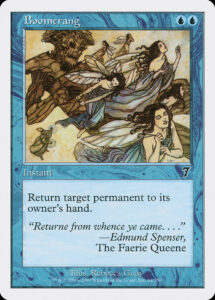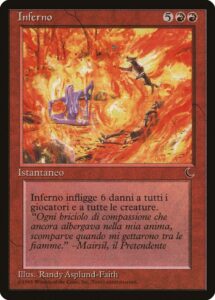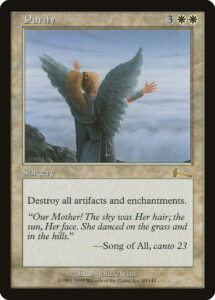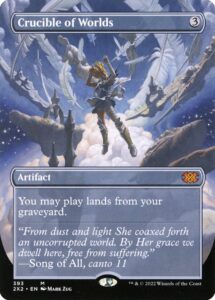Flavor of the Month: Serra's Angel Food Cake

Serra the Benevolent and Dockside Chef | Illustrated by Magli Villeneuve & Steven Belledin
Just Desserts
Welcome to Flavor of the Month, where we use the flavor of cards as a recipe for building spicy decks. Today I'm doing my best Hozier impression and taking us to church: the Church of Serra.
I'm a poet in my life outside of Magic, so whenever I see a word like "canto" in the flavor text of a card, I take notice. That's what drew my attention way back in the day (I'm talking Urza's Saga, back in 1998) to a series of cards that included cantos from something called the "Song of All."
For those who don't know, a canto is a section of a long poem, often numbered, that serves to provide breaks in the piece much like chapters do in a modern novel. If you've encountered cantos before, it'll probably have been in Dante's Inferno or the other books in his Divine Comedy. The canto's first use in English literature was in Edmund Spencer's The Faerie Queene, which has been quoted in MTG flavor text in the past, itself! I wish Wizards of the Coast would go back to pulling real-world text like literature quotes in flavor text as frequently as they used to, but that's a topic for another article.



The Song of All, as it appeared across a number of flavor texts at the time, seems to be a long, religious poem. More specifically, it appears to be either an ode to the planeswalker Serra, founder of the Church of Serra (a major religion on the plane of Dominaria), or the actual religious text of that Church. It tells the story of Serra and the myths and stories that surround her, along with providing a suggested set of morals to live by. (It's worth noting here that, despite the fact that we focus more on its literary influence rather than its religious import today, Dante's Divine Comedy and all its cantos were heavily religious in their goals and subject matter; it's basically a lecture on Christianity and Why You Better Get With It Or Burn In Hell, albeit a literary one).
For example, Canto 904, as printed on Serra Avenger
While we only had a handful of cards giving us sections of the Song of All before--13 by my count--we've received a few more in fits and starts in recent years thanks to our return trips to Dominaria and supplementary releases like Modern Horizons 2 and Secret Lair drops. Enough to sketch out the foundation of a religion-themed Commander deck, I'd say!
Ingredients
All told, we have 20 cards as of the time of writing that include cantos from the Song of All. A lot of them are niche or underpowered, as is often the case with older cards, but we can work around most. A couple, though, are too niche (Abiding Grace
Naturally, we will be including a bunch of Angels, and the planeswalker at the center of the religion herself, Serra the Benevolent
But wait, who's going to lead this holy Angel army, anyway? Angels, with few exceptions, are notoriously mana-intensive creatures, so we could go a long way toward getting around that downside by reanimating them. There is one legendary Angel who reanimates them routinely, in fact: Reya Dawnbringer
Before you hit up the comment section, yes, I see the irony of wanting to cheat out seven- and eight-mana Angels with a nine-mana one. But hear me out: not only does Reya's reanimation mechanic fit flavorfully--resurrection in some form is a major part of quite a few religions--but we have some help in getting her out. And further, filling up the graveyard and choosing the big, splashy Angel we need at that moment is a more reliable gameplan than just drawing them at random and casting them.
Preparation
We're going to ramp as fast as mono-white will allow us--which, granted, is easier now than it ever has been. Cards like Oketra's Monument
Of course, since running a nine-mana commander Commander deck, much like a church, is very expensive, so we should take a page out of the playbook of major religions and do some tithing ourselves.
We're relying on white's recently pushed ability to flood the board with Treasure tokens (ark not included, though you could probably pay for one with Smothering Tithe
Granted, we will be a little vulnerable to aggression while we develop our resources, so the next thematic part of our deck comes in handy: wrathful and unyielding judgment. We have a number of board wipes here, and while we do have a few smaller value creatures, they'll either have done their job already or we can get them back later. Ever since the original Wrath of God

Hey, that's more of the Song of All on Purify
Look, I can't tell you what to do, and as far as I know there are no Commandments about this, but I feel like Armageddon and its ilk are only to be used in situations where they end games. We run one of the best Angels in existence, Avacyn, Angel of Hope
Avacyn will also protect our creatures from our own wraths, as will Sephara, Sky's Blade
And what kind of a religion- and Angel-flavored deck would this be without resurrection, anyway? Thanks to some mill synergies, we're going to have a 'yard full of Angels to reanimate. Perpetual Timepiece
Creatures aren't all we can reanimate, either. Brought Back
As a bonus, the borderless version of Crucible of Worlds comes with a new canto from the Song of All, and the gorgeous art depicts Serra creating her very own plane...which is apparently something she can do.

Yield
Serra's Angel Food Cake
View on ArchidektCommander (1)
Creatures (30)
- 1 Angel of Serenity
- 1 Archangel of Tithes
- 1 Avacyn, Angel of Hope
- 1 Battle Angels of Tyr
- 1 Breathkeeper Seraph
- 1 Burnished Hart
- 1 Devout Witness
- 1 Emeria Shepherd
- 1 Esper Sentinel
- 1 Geode Golem
- 1 Karmic Guide
- 1 Linvala, Keeper of Silence
- 1 Millikin
- 1 Radiant, Serra Archangel
- 1 Sephara, Sky's Blade
- 1 Serra Angel
- 1 Serra Ascendant
- 1 Serra Avatar
- 1 Serra Avenger
- 1 Serra Paragon
- 1 Serra's Emissary
- 1 Solemn Simulacrum
- 1 Starnheim Aspirant
- 1 Tithe Taker
- 1 Voice of Duty
- 1 Voice of Grace
- 1 Voice of Law
- 1 Voice of Reason
- 1 Voice of Truth
- 1 Weathered Wayfarer
Instants (9)
Sorceries (8)
Artifacts (11)
Enchantments (6)
Planeswalkers (1)
That'll do it for this installment of Flavor of the Month. I had to leave some Angels on the cutting room floor to get this deck down to 100; which of your favorites would you swap in? (I know cutting Lyra Dawnbringer hurt the most for me.) What other religion-themed cards are viable options for the deck? Tell me in the comments along with what a bad person I am for suggesting people can play the hated land destruction spell!